![]()
Origins of farming in Bingham
The first farmers settled in Bingham about 6000 years ago. They occupied an area in the southwest of the parish close to Lower Brackendale Farm. Over the next two to three thousand years much of the woodland in the parish was cleared as the population grew and more land was brought under cultivation. By the start of the Iron Age, about 2750 years ago, there were possibly several settlements in the parish, each of which was probably self-sufficient in food. Evidence from excavations outside the parish at Gamston show that crops grown there in the Iron Age included wheat, emmer, spelt, barley, Celtic beans or peas, which are similar to the broad bean and field pea, while bones from cattle, sheep, pigs and horses were found. The distribution of Iron Age pottery in Bingham seems to suggest that most of the parish was either pasture or woodland. Only small areas near the settlements were given to arable farming.
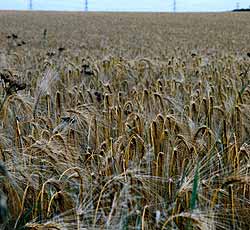 Barley on Starnhill Farm, grown as a second crop after wheat. Photo: Peter Allen |
During the Roman period there was a major change in agriculture, as most of the southern half of the parish seemed to have been given over to arable farming. Bingham then, as now, had good land for growing cereals. During the Roman occupation much of SE England and the Midlands was given over to commercial farming of cereals to support the Roman Army, both in Britain and on the continent. Bingham seems to have been part of that.
Commercial farming collapsed after the Roman Army left in 410AD and, during the 5th to 8th centuries, the time when the Anglo-Saxon established themselves in the region, farming seemed to have reverted to the way it had been in the Iron Age. Areas of arable farming were close to the settlements, while the rest of the parish was probably mostly pasture for grazing stock.
Medieval farming
Bingham is situated in what is called “Champion Land”, that is the part of England where open field farming was practised. In this system of farming each parish was divided into several large, open arable fields, areas of common grazing, woodland and a village green. Each arable field was further divided up into furlongs and each furlong into strips. A strip was a linear piece of land of a size that could be ploughed in one day. They were usually between 8 and 11 metres wide. Strips were allocated among the villagers in such a way that each man had strips in all parts of the manor. Farming was done on a rotation principle usually involving growing cereals and beans or peas in succession with the land fallow in the third year. The date when open field farming began is not clear, though some historians believe it was during the early medieval period.
It is evident from the scatters of 10th century pottery in Bingham that there had been a significant change in farming since the earlier Anglo-Saxon period. Pottery is widely scattered around the parish and no longer are there clusters around settlement sites. As in the Roman period it seems that Bingham was growing cereals on a big scale again. The climate then was warm in the 10th century and commercial cereal farming had returned to England for the first time since the Roman period.
The Domesday Book is the earliest document that gives direct information about farming in Bingham. At that time it is said that Bingham comprised three manors, one large and two small, but after 1066 AD they were united under a single, Norman lord. Most of the land in these manors was arable, but with some pasture and meadow. There was also an area of wood pasture measuring one league (thought to be about 3 miles) by eight furlongs. Wood pasture was similar to parkland in which animals grazed among trees kept for timber or pollarding. There is nothing in the Domesday Book to say where it was, but it was probably located in the western part of the parish, where there is a large area with no pottery sherds from the 10th to the 12th centuries. Documentary evidence from 1237 AD shows that Bingham was buying wood from Haywood Oaks at that time, suggesting that all the southern half of the parish was now converted to arable farming and that the wood pasture had been cleared.
During the 13th and 14th centuries more of the parish was under arable cultivation than at any time before or after until the 20th century. However, possibly as a result of the Black Death in 1348-49 when there would have been a severe labour shortage, large tracts of the northern half of the parish including Parson’s Hill and the flat land to the south and west of it, went over to pasture or waste land.
A major reorganisation of the parish farmland was carried out in the late 15th century. (See manorial survey of the parish) This was when the system of four open fields, common grazing and meadow that is evident on the conjectural map of 1586 seems to have been implemented. The four fields were Starnhill (or East) Field, South Field, Brackendale (or West) Field and North (or Chapel) Field. North Field was divided into two parts. A small outlier near Margidunum was mostly arable. The southern part was arable and meadow. Little is known of the detail of the crops grown in the open fields apart from wheat, oats, barley and beans or peas. The survey of the parish carried out in 1586 made reference to several hundred “beasts” and 2400 sheep.
Although not strictly farming there is evidence on the 1586 map that there were at least two rabbit warrens maintained in the parish providing an extra source of protein for the medieval population.
In the late 16th or early 17th century about half of East Field and a significant part of West Field were converted to pasture, possibly because farming economics had made it favourable to rear sheep. The southern part of East Field that was converted for grazing is the area around what is now Starnhill Farm and this was to remain pasture until the middle of the 20th century.
Open field farming ended in Bingham in 1680-90 AD, when the parish was enclosed. This was a major reorganisation of the land leading to its division into a number of fields, which were let individually to tenants, who were able to farm them according to their own inclinations. Common grazing on West Moor continued for another century.
17th and 18th centuries
The open field system of farming ended around 1680-90, when the parish was enclosed and the open fields divided up into many small closes (fields in modern terms), which were cultivated by tenant farmers.
In her book, Bingham in the past, Elizabeth Foster has examined several sources to find out about farming in the seventeenth and first half of the eighteenth centuries. She came to the conclusion that apart from a very few tradesmen who lived entirely by their trade everyone in Bingham had some connection with the land. They were either farmers or farm workers or, if they were trades people, they reared some livestock or grew crops to provide food for the kitchen and to supplement their income. Indeed, the early nineteenth century maps of Bingham show that most houses were situated along the main east-west roads and had narrow strips of land behind them. It is thought that this pattern had remained unchanged since the Middle Ages.
An examination of inventories carried out by Elizabeth Foster showed that in terms of value, agricultural assets were ranked in the order, arable, horses, sheep, cattle and pigs. Of these, cattle and pigs were fairly small. Bingham had never been a significant area for dairy farming and pigs were usually kept, along with poultry and other animals, only for the kitchen.
19th century
In 1840 there were 89 people, including the Rector, listed in the Tithe Awards as owning or renting meadow, pasture or arable land in the parish of Bingham. Amongst them there were 25 farmers with more than 20 acres. Most of the others were cottagers and householders, some of whom had as little as an acre.
Andrew Esdaile in his Historical Account of Bingham, published in 1851, says that in that year there were 26 farmers and the Rector with 20 to 200 acres and 21 cottagers who grew corn (as distinct from householders with a patch of land). The number of farmers dropped from then on, reaching 14 during the 1870s and remaining fairly stable at this level until the 1960s.
Farmers in Bingham 1840 to 2003
| Total farms Farms of more than 150 acres Farms of less than 20 acres Smallholders/cottagers(3) Market gardeners and nurserymen, gardeners |
1851 26 5 -- 21 -- |
1871 20 6 -- 23 2 |
1881 14 4 -- 16 2 |
1891 15 NA 22 7 |
1908 15 NA 7 |
1922 14 NA -- 1 9 |
1941 14 7 NA 1 3 |
2003 11 8(1) 4(2) -- 1 |
Notes
1. Four of the farms are managed as two farm units. Two others are part of a consortium. Most of Bingham’s farmers have land outside the parish. The smallest farmed unit among them is 550 acres.
2. These are single fields rented by farmers who have larger farms outside the parish.
3. This category includes cottagers, smallholders, cottager-farmers and farmers with less than 20 acres.
The number of farmers with more than 150 acres varied between four and six through the nineteenth century and there were always some quite big farms. In 1840 the largest farmer was John Hutchinson, who lived at Starnhill Farm. He had 259 acres, all rented from the Earl of Chesterfield. An ancestor of his, also John Hutchinson, yeoman, was the biggest farmer in Bingham in 1723. Also in 1840, John Foster and William Pacey farmed over 200 acres of rented land. The largest landowner, besides the Earl of Chesterfield was Samuel Walker who farmed 103 acres.
Thirty years later the biggest farms were twice the size they had been in 1840. In 1871 John Foster farmed 500 acres with 8 men and 3 boys and John Hutchinson’s tenancy had increased to 386 acres. However, Robert Brewster may have had more than either of them. His acreage was not quoted in the 1871 census, but he employed 12 labourers, which is more than John Foster, and in 1881 he had 600 acres and employed 17 labourers. Another huge farm in 1881 was Ann Brett’s, with 511 acres.
Information about crops that were grown in Bingham during the nineteenth century comes mainly from Robert Hart’s farm accounts for the period 1846 to 1861. These were found written on the back of the draft register of Baptisms for 1792-1806 and are held in Nottinghamshire County Archives. Crops specifically mentioned in the accounts include onions, kidney beans, Regent and Prophet potatoes, clover, mangolds, swedes, wheat, barley and hay. Another farm diary for 1843 to 1847, kept by Henry Smith, who farmed in Cropwell Butler, lists pigs, cattle, horses, sheep, oats, barley, wheat, beans, lentils, red clover, grass for seed, swedes, green barrel turnips, clover for seed and hay. He also lists the game he shot in each year. In 1847 he killed 53 hares, 37 partridge and 7 pheasant.
Crops grown in Bingham since 1850
| 1850 - 1880 wheat barley potatoes onions peas mangolds swedes turnips clover hay kidney beans carrots lentils |
1940 –1960s wheat barley potatoes peas mangolds swedes turnips clover hay field beans tic beans kale rye oats sugar beet |
2002/2003 wheat barley potatoes onions peas sugar beet oilseed rape linseed Phacelia |
There is no indication of the size of Robert Hart’s farm in the accounts, but in the 1871 census he is said to have 17 acres. He described himself in the census as a cottager. In 1855 Robert Hart paid £1 : 4s : 4d for a year in rent to Lord Chesterfield and tithes of £7 : 15s : 4d for the same year. He also had to pay Land Tax and there is a mention of paying £8 interest to Mr Pacey. He sold his haystack for £32 in 1846. In 1861 he sold 7 tons of swedes to Mr Chettle. The previous year he bought two pigs by auction in Bingham Market from Mr Oakes. One was for £1 : 1s : 6d; the other 10/6d. Other interesting items include the hire of Mr Strong’s steam threshing machine for his wheat and barley in 1855, the dispatch of his wheat to Nottingham by train, the purchase of 2 loads of gas lime to kill slugs on 1 ½ acres of potatoes in High Close, the hire of 8 Irishmen to cut 2 acres of red wheat in the Old Close at 13/- an acre and the hire of Mr A. Footit’s donkey for 8 weeks and 4 days.
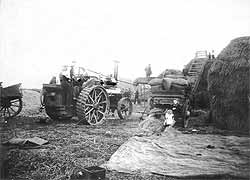 Harvest at Saxondale in 1896. The steam tractor has a vertically mounted drive wheel carrying a belt to drive machinery that is out of shot, but which might have been a threshing machine. Photo: courtesy Greg Franks |
An interesting insight
into mid-nineteenth century farming is provided by the
Weslayan school logbooks
for the period 1863 to 1879. The dependence of the cottagers
and farmers on child labour is continually made, as is
the dependence of the poor families on wages brought in
by the children. Even when school attendance was made
compulsory in 1872 absenteeism remained high. Many reasons
for being absent were given by the master, Thomas Jones,
including:
|
Besides these jobs, children were required for stone picking, to tend the horses, help with the ploughing and work in the stack yard. Girls were often taken out of school to look after younger siblings while their parents were working in the fields. Even when they attended school the children would not always stay the full day. The master complained that they left at 11.30am to take dinner to their fathers in the fields and again at 3 or 3.30pm to take tea and to gather fruit in the orchards. Most poignant, however, was the comment in February 1865 that two more children had left Bingham, bringing to 30 the total lost to the school because of the severe winter weather and no farm work in Bingham. Almost as hard for the parents was the following summer, which was extremely wet and caused much delay in gathering the harvest. In this case school attendance was high, when normally the children would have been out in the fields earning money.
Orchards
In 1942 there were 2500 acres of orchard in Nottinghamshire, most of which were west of the Trent. Only Bingham and Newark were notable fruit-growing areas on the east of the river. 70% of the orchards were planted on the red clay soil of the Triassic Mercia Mudstone Group. Throughout the county they were grass orchards and it was common for them to be grazed by poultry. Because most were fairly small they were usually combined with market gardens.
The earliest reference to orchards in Bingham, so far found, is to the area now bounded by Long Acre, Market Street, Union Street and Needham Street being an orchard in 1758. The Tithe Awards for 1840 lists about 10.5 acres of land under orchard in Bingham. They ranged from just less than half an acre to 1.25 acres. On the 1883 map there were more than 24 acres of orchard, including plantings in gardens and near farmhouses, but the largest was still only around two acres. This level of fruit cultivation continued until after the Second World War.
Apples, pears, plums, damsons, cherries and gooseberries were all grown here and there is a single reference in the parish magazine for March 1869 saying, for February, “apricots are in full bloom”. The Bacon family, who still retain a small orchard in The Banks, trace their involvement in orchards to 1840 when the first of their family to live in Bingham came here from Norfolk. He is credited with introducing the Victoria plum to Bingham and most references to Bingham’s orchards say that it was noted for its plums.
The varieties of fruit grown can be guessed with reference to surviving trees in remnants of the old orchards and varieties remembered by old residents of Bingham. Among apples Bramley Seedling was the commonest and there is one tree surviving that was grown from a cutting taken off the original tree in Southwell. Other apples known to have been grown here are Howgate Wonder and Warner King, both cooking apples, Russet and Cox’s Orange Pippin. Information can also be gleaned from Henry Smith’s list of the apple trees he planted at his farm in Cropwell Butler in 1841. The twelve varieties listed were Greenups Pippin, Northern Greening, Billage Pippin, Caldwell, Margell, Lord Lennox, Pike’s Permain, White Hawthorn Dean, Walker’s Summer Broading, Clifton’s Nonsuch and Blenheim Orange. Of these only Blenheim Orange, Lord Lennox and Northern Greening are in the list of apple varieties kept by the Brogdale Horticultural Trust, which holds the national collection of 2400 varieties of apple.
Besides the Victoria plum there were greengages and goldengages, all of which survive in the remains of the Bacon’s orchard in the grounds of Toot Hill School. The commonest damson was Merryweather, which is a specifically Nottinghamshire variety.
Market gardeners
The name by which those who work small land holdings are called has changed with time. Until the end of the nineteenth century the term cottager generally applied to someone who owned a small piece of land within which they lived and on which they had orchards, grew crops or kept livestock. However, it is not uncommon for the same individual to call himself a cottager in one census and farmer in the next. The term market gardener appears in the 1871 census, but in 1891 there are only cottagers and gardeners. Market gardeners reappear in Kelly’s directory for 1908 and from then on there are market gardeners, small holders and nurserymen. Judging from the names of the people involved the terms market gardener, gardener and cottager have been synonymous.
Up to the end of the nineteenth century there were as many as 29 cottagers, market gardeners, nurserymen and smallholders in the parish. Gladys Marian Benton, writing about the period up to 1903, when she left Bingham, recalls the market gardeners selling fruit and vegetables house to house from their handcarts every Saturday morning. During the first decade of the twentieth century, however, there was a sudden drop in their numbers. Seven are recorded in 1908, ten in 1922, four in 1941 and in 2003 there was one garden nursery. Anecdotal evidence suggests that in the twentieth century the smallholders and market gardeners kept pigs and poultry, grew vegetables and kept the orchards. There is, however, a problem with numbers here. Orchards continued to be commercially exploited until the big expansion of Bingham in the 1950s, which suggests that many of them were owned by individuals who identified themselves in some other way than as market gardeners in the directories.
20th century
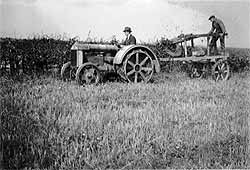 The tractor towing a trailer on which is mounted a rotating cutting wheel for trimming the hedges is a Fordson E27N, which was manufactured in 1932/33 and was powered by petrol and paraffin. The picture was taken on Starnhill Farm sometime after that. Photo: courtesy Greg Franks |
From the mid nineteenth century to 1940, British farming was in decline and Bingham did not escape the impact. In the second half of the nineteenth century unemployment rose in Bingham as result of the collapse of the framework knitting cottage industry, a gradual reduction in the demand for lace-making outworkers and loss of work on the farms. The population of Bingham fell from 2,054 in 1851 to 1,487 in 1891 as people migrated to the nearby towns in search of work. It increased only slowly in the first half of the twentieth century, reaching 1597 in 1931, but not because of any change in fortunes on the land. By then farming had ceased to be the major employer in Bingham.
From the 1830s steam-power was beginning to be used to drive farm machinery and by the 1850s steam-powered ploughs, cultivators and threshing machines were in use throughout the country. It continued to be important until after the First World War and in Bingham steam ploughs were used on Starnhill Farm between the wars. However, it was the use of the internal combustion engine in farm machinery that brought about a true revolution in farm mechanisation and led an amazing period of change. Between 1948 and 1965 the number of working horses in Great Britain fell from 457,000 to 26,000. Combine harvesters went up from 5225 to 57,950. In the fifty years between 1948 and 1998 the total labour force on British farms fell from 849,000 to 248,000. At the same time yields per acre for almost everything grown doubled or tripled. The level of self-sufficiency for indigenous food types rose from 45% to just over 82%.
In 1925 the Crown Estates bought nearly all the farm land in Bingham and all the farmers since then have been tenants of the Crown. For the most part individual farms were rented separately, but during the 1920s there was a period when Hardstaff & Brown, the grocers in Market Place, formed a company and rented Starnhill, Foss and the Brackendale farms. They were managed for the company by farm bailiffs.
In Bingham, the Cockaynes, who have farmed the Top and Middle Brackendale farms since 1935, bought their first tractor just before the Second World War. Howard Lamin bought his first combine harvester, a Massey-Harris from Canada, in 1949. In 1940, in Britain it was not economical to buy a combine harvester for less than 100 acres of grain. By 1946 both W.A Hutton at Newgate Street farm and Howard Lamin at Starnhill had ceased to use horses and in the early 1950s working horses had all but disappeared from the parish.
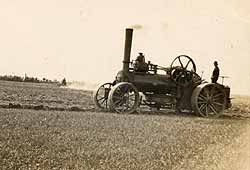 |
Steam
ploughs at work in fields near Rampton, Nottinghamshire,
in 1928. The winding drum is clearly seen beneath the
boiler. In the distance is another engine. The plough
is between the two throwing up a cloud of dust behind
it. The way this system worked was for the two engines
to power a cable to which the plough was attached. The
cable was used to pull the plough, with a man sitting
on it to steer it, across the field between the two
engines. When one pass was completed the two engines
moved forward so that the plough could then work the
next row. There were many variations on this theme,
some requiring only one engine. They are described in
a book Ploughing by Steam, by John Haining and Colin
Tyler (Ashgrove Press, Bath, 1970.) Published by Guy & Co, Nottingham. Photo: courtesy of Greg Franks |
Up to the early 1960s all of Bingham’s farms were still essentially mixed and there remained some smallholders among the big farms. There were some small to medium-sizes dairy herds and cattle were brought in for fattening. Several farmers kept small flocks of sheep and there was a communal sheep dip near Moor Bridge. Most farms had a few pigs, mainly for the kitchen, but they were the mainstay for one or two of the smallholders and in the 1930s Howard Lamin kept a large herd of pedigree Middle White pigs. Mrs Warner kept 200-300 turkeys for Christmas sales and there were one or two farms and smallholders with a substantial number of laying hens. The range of crops grown included wheat, barley, oats, rye (grown only on Lower Brackendale Farm), potatoes, peas (for the food processing plant in East Bridgford up to its closure in 1957), sugar beet, kale, mangolds, swedes, clover for seed, tic beans (for pigeon food), field beans (for horse food), ley (clover and rye grass for horse hay), clover to plough in as green manure and grass. The dominant crop, however, even then, was wheat. The crop plan for Upper and Middle Brackendale farms in 1948, when they had two horses, shows wheat, with 51 acres to be their main crop. They had 27.75 acres of barley and 7 of oats. By 1951, with one horse, they had 86 acres of wheat and 19 of barley.
During the 1950s and early 1960s a major reorganisation of the farms took place as a result of initiatives taken by the Crown Estates, the landowners. In response to the County development plan for Bingham, which had in it a requirement not to mix farming and domestic buildings (see Bingham developed and redeveloped.), new farms were built outside the town. At the same time, the Crown Estates rationalised the land holdings in order to build up a contiguous area for each farm. Prior to that, individual farmers had worked fields that were scattered about all over the parish. The Crown Estate also created larger farm units and reduced the number of farm tenancies in the parish.
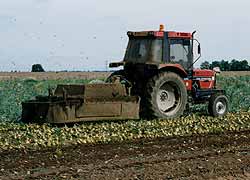 Onions grown on Starnhill Farm are topped mechanically before being harvested. Photo: Peter Allen |
The trend away from mixed farming began during the early 1960s. Individual farmers had their own reasons for selling off the dairy herds, but they included the costs attached to the introduction of TT testing and the need to raise capital to invest in machinery. With no cattle and horses to feed more land became available for arable farming. In the north-eastern and south-eastern parts of the parish hedges were removed to make large fields more suitable for the monocultural regimes that were coming in and the farming landscape in Bingham changed completely.
As one example of how the farmers reacted to external economic pressures during this period, the story of Starnhill Farm is illustrative. Arthur Howard Lamin came to Starnhill Farm in 1930, when it was 337 acres and run as a typical mixed farm. When his son, Peter, joined him in 1954 he brought an interest in horticulture and sought to diversify by putting 25 acres to horticultural crops delivering to the wholesale market. They grew cabbages, cauliflowers, lettuce, celery, runner beans and carrots, but the arrival of supermarkets on the retail scene made this venture uneconomical and it was stopped in 1962. Just before this, in 1960, the herd of pedigree Friesians was sold to buy more land to improve economic effectiveness of the farm unit as a whole. They continued to bring in livestock for fattening for a while, but this ended in 1963/64.
Still influenced by his interest in horticulture, Peter Lamin then joined with six other farmers in the area to form Nottinghamshire Bulbs, which grew tulips. Some were sold as cut flowers, but most were headed and the bulbs sold on to be grown in heated greenhouses for winter flowering. At the peak there were 18 acres of tulips on Starnhill Farm. Then, during the oil crisis in 1973/74 the price of fuel for heating rose to such heights that the winter forcing business collapsed and Nottinghamshire Bulbs closed down. This venture was not the first of its kind in the area. In the 1950s Dennis Richardson of Saxondale grew daffodils commercially and even now, in the spring daffodils from stray bulbs can be seen along the side of the A52 west of Saxondale.
By this time, the range of crops grown on the farm was beginning to narrow. Potatoes had been grown on a field scale since 1930 and in the 1960s the acreage at Starnhill was increased to 120 acres. Irrigation was introduced in 1958. In recent years the potatoes were used mainly for French fries and they remained a major crop until 2002, when competition from Holland and Belgium made it uneconomical for them to continue.
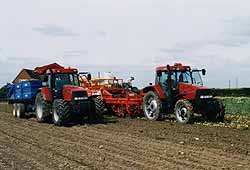 Winter onions, harvested by contractors on Starnhill Farm, are lifted five rows at a time at walking pace and loaded onto a trailer via a conveyor belt. Photo: Peter Allen |
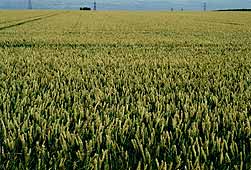 Wheat is one of the main crops grown in Bingham. It is used for biscuits or pet food; some is used for bread. Photo: Peter Allen |
Onions had been grown on a field scale since 1970, when both spring-drilled and winter onions were grown. The spring-drilled onions were sold via a co-operative in Boston to Safeway and Sainsbury. The arrival of ASDA as a competitor forced Safeway and Sainsbury to reduce the number of their suppliers and Starnhill ceased growing spring-drilled onions. The farm continues to grow winter onions, which are used in processed food.
By 1999 the farm grew wheat, barley, oil-seed rape, sugar beet, potatoes and onions. They rented 550 acres within the parish out of a total of 1150 acres.
21st century
In 2004 there are three main farming units within the parish. Starnhill Farm and Holme Farm are joined within a company called FARMECO; Whitefields and Spring farms are worked by the Hammonds as a single unit. The Brackendale farms are also worked as a single unit. A farmer no longer lives in the house on Brocker Farm. The land around it is rented by Neil Stubbs of Wiverton Hall Farm, which is outside the parish. James Fisher from Newton rents all the land west of Chapel Lane. Four other farmers either own or rent four other fields. There is one garden nursery.
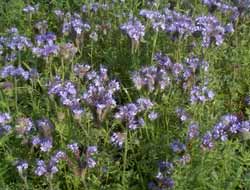 Phacelia, introduced from Germany, is grown on set-aside and used as a green manure. In UK it cannot be cut before early July to enable honey bees to take full advantage of it. It has been grown on Holme Farm in Bingham. Photo: Peter Allen |
The main crops grown are wheat, barley, oil seed rape and sugar beet. Onions are still grown on Starnhill Farm, peas on Brocker Farm. Industrial oil seed rape, linseed and Phacelia have been grown on set-aside in the last three years. The only livestock anywhere in the parish are a few cattle grazed on Crow Close, sheep brought in for winter grazing, and horses. Mostly the horses are kept for private recreational use, but at Starnhill Farm there is the Midlands Equine Therapy Centre, which provides hydrotherapy spa treatment for horses.
The trends in farming are clearly for the minimum viable unit to continue to increase in size and for manpower to decrease. In 2003 Neil Stubbs, of Wiverton Hall Farm and Brocker Farm, worked alone on 550 acres. Contrast this with John Foster who had 500 acres in 1871 and employed 8 men and 3 boys to help him. The two Brackendale farms, which total over 800 acres including land outside the parish are run by three full-time men aided by one part-timer during harvest. An interesting development is FARMECO. This company was formed as a partnership of Holme Farm, Starnhill Farm and two other farms outside the parish. It owns nearly all the farm machinery and employs all the labour working on these farms and others where they have contracts. In total they farm over 6000 acres. The company employed four full-time staff supplemented by an extra seven during harvest in 2003. Not only does this arrangement drive overheads down, the economy of size enables them to maintain the most up-to-date machinery and utilize modern innovations such as Global Positioning Systems (GPS) and infrared satellite imagery for determining spray patterns for crops. The company also employs minimum cultivation on all its land and does not plough. They were the first in Bingham to use Phacelia as a green manure.
Information in this section has come from many sources. To find what they are click here.
